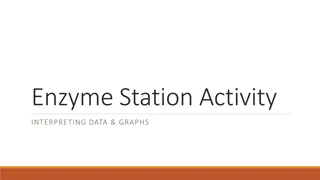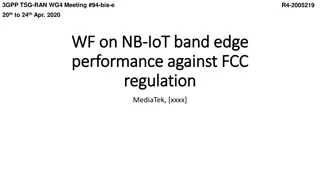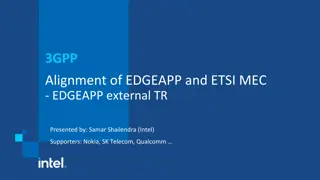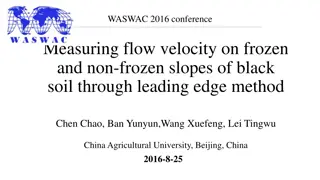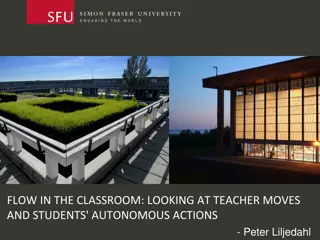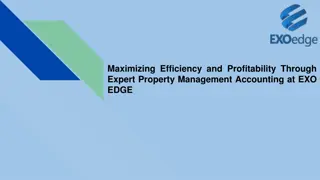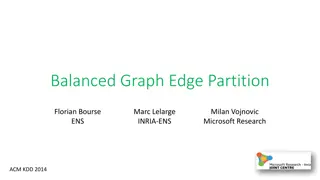
Optimal Edge Preserving Restoration Methods Explained
Explore the innovative techniques for optimal edge preserving image restoration with efficient regularization as discussed in a seminar by Dr. M. Arfan Jaffar Mohsin Bilal. The presentation covers spatial degradations, proposed restoration methods, optimization challenges, and more. Discover how blurring, noise, and motion affect image quality and learn about space invariant and space variant degradations. Gain insights into image restoration processes and models for addressing degradation factors.
Download Presentation

Please find below an Image/Link to download the presentation.
The content on the website is provided AS IS for your information and personal use only. It may not be sold, licensed, or shared on other websites without obtaining consent from the author. If you encounter any issues during the download, it is possible that the publisher has removed the file from their server.
You are allowed to download the files provided on this website for personal or commercial use, subject to the condition that they are used lawfully. All files are the property of their respective owners.
The content on the website is provided AS IS for your information and personal use only. It may not be sold, licensed, or shared on other websites without obtaining consent from the author.
E N D
Presentation Transcript
Optimal edge preserving restoration with efficient regularization Seminar By Dr. M. Arfan Jaffar Mohsin Bilal, M. A. Jaffar, Optimal edge preserving restoration with efficient regularisation, The Imaging Science Journal, 63(2):68-75. 2015 (indexed by ISI Impact Factor 0.598). 3/19/2025 Seminar Presentation 1
Presentation Outline Introduction: Spatial Degradations Proposed Methods for SID Optimal Restoration with Regularization Conclusion & Future Work 3/19/2025 Seminar Presentation 2
Introduction During image acquisition, it is quite unavoidable to have a faithful representation of the scene to be recorded. Hence every recorded image is more or less blurry. Blurring is the linear process which spreads the scene information to the neighboring pixels; eventually, the loss of small scale details happens Point spread function (PSF) is the general model that can result the same blurring effect if an image is convolved with it. Causes of Blurring: imaging technology limitation of resolution and recording speed. Atmospheric turbulence, camera or object motion during recording, object occurrence outside the depth of field of recording device, all these situations yield blur, motion blur and out of focus blur respectively in the recorded image. 3/19/2025 3
Introduction Image Restoration To deal with images degraded with blur, noise or both. Image restoration attempts to obtain the original image given the degraded image with some knowledge of degradation factors Image Restoration of spatial degradations is an interesting field providing challenging problems. Optimization of the ill-posed inverse problem Dealing with conflicting objectives - making a tradeoff between smoothness and sharpness. Degraded Image Formulation of Degradation Model Information about Image Acquisition Degraded Image Estimated Image Inverse Degradatio n Process 3/19/2025 4
Spatial Degradations Common degradations are blur, noise and motion. Space invariant Degradation (SID) - Image suffers degradation with a single blurring kernel or Point Spread Function (PSF). Space Variant Degradation (SVD) - different spatial locations suffer different form of degradation i.e. different spatial locations have different PSF. Generally, caused by problems with the imaging system such as distortions in optical system, global lack of focus, object being outside the depth of camera s field or camera motion 3/19/2025 5
Space invariant Degradation Model In matrix form the model is expressed as = + g H f Where, f, ?and g are m-dimensional column vectors and B is the m-dimensional matrix. H is a blur function, either a block-circulant matrix or block-Toeplitz matrix. 3/19/2025 Seminar Presentation 6
Restoration of SID Lets ? = 0, SID model becomes ? = ??, which is an inverse problem and can be solved as ? 1?, arg??? ? Direct Method ? = 2, ? ? ? Indirect Method If ? 0, inverse problem becomes ill-posed, can be solved as ? = arg??? ? Regularization filtering (RF) 2+ ? ( ?) CLSE ? ? ? 3/19/2025 Seminar Presentation 7
Adaptive Restoration via Regularization The restoration is challenging due to: non-stationary nature of the image unknown random additive noise conflicting objective of deblurring and denoising 1. 2. 3. Regularization is the remedy to deal the above challenges Regularization parameter tries to enforce some balance between the residual and smoothness terms Too great a value of ? will oversmooth the restored image, whereas too small a value of ? will not properly suppress noise. 3/19/2025 8
Proposed Regularization Regularization term: Difference of every gray value with the average of all gray values in the estimated solution. ( ) ( ) x x = 2 N 1 N p 2 = x x p = 1 where x is the m-dimensional vector of the estimated image, and xp is the grey value of pixel at location p in the estimated solution x. The regularization parameter : is a ratio between fidelity term (the difference between the estimated solution with the degraded image) and the proposed regularization term, (the difference of every pixel with the average of all grey values) [0] g Hx x = [0] ( ) 9 Seminar Presentation 3/19/2025
Restoration by Optimization In order to search for the optimal solution, a gradient based approach is used based upon the idea of steepest descent, which searches for the estimate of x which minimized following error function Restoration by searching global minima for: 2 N 1 N p 2 = + ( ) * E x y h x x x p 2 = 1 The search is performed by steepest descent algorithm, which moves the estimate in the gradient direction: ( ) + [ 1] [ ] n [ ] n n x ( 1 x x = ) E [n] g Hx x ( ) ( ) = [ ] n = E x H g Hx 0.1 [n] ( ) 3/19/2025 Seminar Presentation 10
Performance Measures Most commonly used performance measures for Image Restoration include: Signal-to-noise-ratio (SNR) M N ( ) 2 ( , ) O i j = = 1 1 i j = ( , ) 10log SNR F O 10 M N ( ) 2 ( , ) O i j ( , ) F i j = = 1 1 i j Peak-signal-to-noise-ratio (PSNR): It is a global performance measure PSNR can be defined as 2 S = ( , ) 10 log PSNR F O 10 ( , ) MSE F O 1 M N ( ) = i 1 2 = ( , ) , ( ) , ( ) MSE F O O i j F i j MN = 1 j 3/19/2025 11
Results Blur operator H comprising of 3*3 Gaussian PSF kernel with the std 2 3/19/2025 Seminar Presentation 12
Result of proposed algorithm with varying PSF sizes 3/19/2025 Seminar Presentation 13
Experimental Results (a) (b), 8.22 (c), 16.03 (d), 16.93 (e), 19.45 (a) Original (b) Degraded (c) Neural Network (d) Mignotte and (e) Proposed Solution Seminar Presentation 3/19/2025 14
Comparative Analysis Image Restoration Techniques SNR Space Variant Adaptive 2.07 HNN Algorithm 5.94 Harmonic Algorithm 6.49 Total Variation algorithm 9.55 Spatially Adaptive Image Restoration 5.27 Multiscale neural network Technique 7.81 Biouscas Dias 8.10 Mignotte 8.71 Proposed Solution 11.43 3/19/2025 Seminar Presentation 15
Summary An efficient gray scale average based regularization term is proposed for the smoothness of solution in objective function. Restoration estimate is obtained iteratively by applying steepest descent approach. 3/19/2025 16
Sultan Zia, M. A. Jaffar, Cross-Cultural Emotion Classification based on Incremental Learning and LBP-Features, Applied Mathematics & Information Sciences, 9, No. 5, 2651-2656 (2015)
Introduction A number of studies have shown that facial expression representations are cultural dependent and not universal. Most facial expression recognition (FER) systems use one or two datasets for training and same for testing and show good results. While their performance mortify radically when datasets from different cultures were presented. To keep high accuracy for a long time and for all cultures, a FER system should learn incrementally. We proposed a FER system that can offer incremental learning capability. Local Binary Pattern (LBP) Features are used for Region of Interest (ROI) extraction and classification. We used static images of facial expressions from different cultures for training and testing. 3/19/2025 Seminar Presentation 18
Introduction Automatic FER is still a challenging problem due to illumination, head pose, aging, glasses, cultures and races. Even, human cannot 100% recognize facial expressions due to many reasons. First, different people interpret expressions differently for example, fear expression images, which interpreted as fear in America and most of the other countries are mostly interpreted as surprise in Japan. Second, people from different cultures think about facial expressions in different ways, for example, in some cultures, people focus on mouth but in others focus on eyes etc. Third, in different cultures expressions are expressed in different ways i.e. not all the facial expressions are innate and universal. 3/19/2025 Seminar Presentation 19
3/19/2025 Seminar Presentation 20
3/19/2025 Seminar Presentation 21
3/19/2025 Seminar Presentation 22
Five datasets used JAFFE, Cohn Kanade, MUG, FEEDTUM and our own dataset of colored images of Indian subcontinent people, movies and videos 3/19/2025 Seminar Presentation 23
3/19/2025 Seminar Presentation 24
3/19/2025 Seminar Presentation 25
Conclusion A proposed a method for automatic facial expression classification using incremental learning and local binary patterns histogram features. The proposed system has ability to learn incrementally and can accommodate future data. Due to incremental accommodate itself in different cultures. The experimentation performed is showing promising results. learning ability it can 3/19/2025 Seminar Presentation 26









